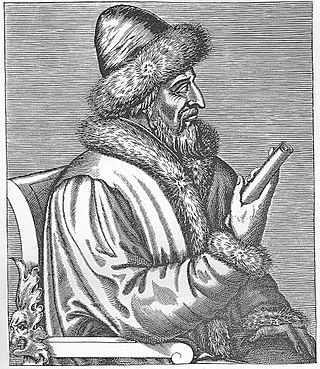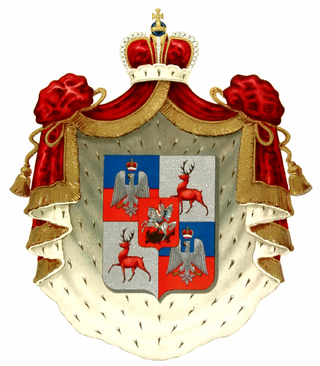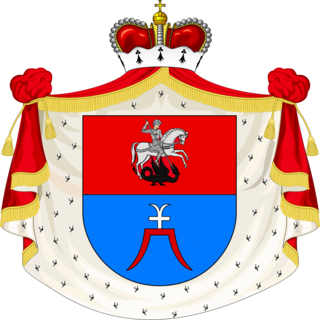History
Mostly because the archival documentation of the 14th century is weak, thanks to Mongol depredations, their precise lineage from Rurik is under shroud. Their tradition, as well as that of the family of Oginskis, refer to them being descended from rulers of the principality of Kozelsk. Several versions of their precise Rurikid origins have been presented.
The Rurikid dynasty's branch of Kozelsk flourished in the 14th century. As one of the Oka principalities in the region of Upper Oka, near Smolensk. These princes were said to be descended from Saint Michael of Chernihiv who was martyred in 1246. (It is generally in published family trees that their one forefather was St.Michael's descendant prince Tit - but nothing more is actually known of this Tit than merely his name, without even explicit attestation of his patronymic, and names of one or more of his historically attested sons, and that in those generations his family -branch- held Kozelsk and Karachev. We can be relatively certain of this Tit's existence because at least one son of his in mid-14th century carried the patronymic 'Titovich' in his near-contemporary documentation.) Better historical sources know the early forefathers of the Puzyna and Oginskis, princes bynamed Hlazyna and Gluszonek who were magnates in the region of Smolensk in the late 15th century. These princes Hlazyna would thus have been descendants of some branch of Dukes of Kozelsk.
In 1408 the Duke of Kozelsk held Rzhev, had the town built. He was possibly merely a kinsman of the Oginski and Puzyna ancestors, and not their direct forefather, as the Kozelsk family seems to have developed several branches already prior to that date.
- There are historically weak beliefs that the Puzyna were branched from the Oginskis by the somewhat unhistorical brothers Grigor 'the fire' (for his hot temper) and Valadimir 'the bubble' (for being obese), allegedly respectively forefathers of the Oginski and the Puzyna, who would have been sons of a prince Tit or a prince Juri or a prince Tit-Juri, of Kozelsk, one allegedly in the 15th generation from Rurik. However, sources contemporary to those centuries do not mention such things (source: Rodoslovtsah). These still have found their way to a lot of genealogies (compare for example the publications of Peter V Dolgorukov). Quite possibly, this another, later Tit is just a genealogically invented ghost of the real Tit whose existence is known from his son's patronymic.
In 1486, boyar Dmitrijus Ivanovicius Hlushonokas received the manor and fief of Oginty in Zhizhmorski, Lithuania proper. His descendants became known as Oginskis, the Lithuanian branch of the Hlazyna. Prince Teodoras Bogdanaitis appears as the first of this lineage with the byname Oginski.
In the early 16th century, Dmitrijus' younger brother, the Belarusian prince Ivan Ivanovich Hluszonak was contemporary of king Sigismund I of Poland as well as his official, and his son prince Timofej Ivanovich was known with byname 'puzyna'. It was this branch which developed to the lineage of Puzyna. Vasilij Ivanovich received from king in 1516 the estate of Nosov in Melnitski (Археографический сборник документов, относящихся к истории Северо-Западной Руси, t. 3, №4, p. 4-5). It seems that these persons are present in later generations of Puzyna in the works of Dolgorukov, as well as in the findings of the Polish Jesuit Andrzej Pezharski, in his book 'Annibal ad Portas'. The name of Puzyna appears to have been found in chronicles in the 16th century.
So, the two bynames (Oginskis and Puzyna) actually formed only in later generations of the two brothers, and not yet to the two brothers themselves. But it has been easy although mistaken to try to make already two brothers to carry the nicknames. Since bynames of the real historically attested brothers Dimitrijus and Ivan were actually not such, this has presumably led to confusions about what were the first names of the two brothers who started the branches, some thus picking up the unhistorical names Grigor and Valadimir, as well as the 'mythical' forefather name Tit (who was real person in the ancestry but farther back) as their father.
These two brothers (Dimitrijus, Ivan) were sons of prince Ivan Vasilievich, son of one Vasili Hlazyna, a Ruthenian princely magnate in region of Smolensk. All in all, prince Ivan Vasilievich had five sons: Dmitri, Ivan, Leo, Michael and Andrew, according to Ptashitski.
Vasili Hlazyna's other son (according to S L Ptashitski) was prince Olehno Vasilievich, who fled to Moscow and thus left Belarusia-Lithuania.
The princes of Puzyna have as their earliest historically attested patrilineal forefather the said Vasili Hlazyna in the mid-15th century - just as the record-harmed Mongol-domination epoch was over. In light of strict research, there is not an attested lineage back to Rurikids. They just appear from post-Mongol mists of history. However, the princely title which was accorded to the family, speaks for a Rurikid patriline. The Rurikid DNA project by Y DNA evidence has proven that the Puzyna belong to the patriline of the Rurikids. The tradition being Rurikid is correct.
Material: Russian Wikipedia

Ivan I Danilovich Kalita was Prince of Moscow from 1325 to at least 1340, and Grand Prince of Vladimir from 1332 until at least 1340.

Simeon Ivanovich, also known as Semyon Ivanovich, nicknamed the Proud, was Prince of Moscow and Grand Prince of Vladimir from 1340 to 1353.

Vasili III Ivanovich was Grand Prince of Moscow and all Russia from 1505 until his death in 1533. He was the son of Ivan III and Sophia Paleologue and was christened with the name Gavriil (Гавриил). Following on the ambitions of his predecessor Ivan, Vasili conquered Pskov, Ryazan and Smolensk as well as strengthening Russian influence in Kazan and to the Volga region. Several nobles were either exiled, sentenced or executed for criticizing his policies.

Vasili IV Ivanovich Shuisky was Tsar of all Russia from 1606 to 1610, after the murder of False Dmitri I. His rule coincided with the Time of Troubles. He was the only member of House of Shuisky to become tsar and the last member of the Rurikid dynasty to rule as tsar.

Prince Daniil Vasiliyevich Shchenya was a Russian military leader during the reigns of Ivan III and Vasili III.

The House of Shuysky was a Rurikid family of Boyars descending from Grand Duke Dimitri Konstantinovich of Vladimir-Suzdal and Prince Andrey Yaroslavich, brother to Alexander Nevsky. The surname is derived from the town of Shuya, of which the Shuiskys gained ownership in 1403. From 1606 to 1610, Vasili Shuisky ruled as tsar over Russia during the Time of Troubles.

Elena Vasilyevna Glinskaya was the grand princess consort of Moscow as the second wife of Vasili III of Russia, and de facto regent of Russia from 1533 until her death in 1538. She was the mother of the first crowned tsar Ivan IV.
Zakhary Ivanovich Koshkin was a boyar at the court of Vasili II. He was a male-line forefather of the Romanov family, and the first Romanov Tsar, Michael I of Russia, was his agnatic descendant.
Nikita Romanovich, also known as Nikita Romanovich Zakharyin-Yuriev, was a prominent Russian boyar. His grandson Michael I founded the Romanov dynasty of Russian tsars.

Sophia Vitovtovna of Lithuania was the grand princess of Moscow as the wife of Vasily I from 1391 to 1425. She was regent for her son Vasily II from 1425 to 1432. Her father was Vytautas, the grand duke of Lithuania.
Skalmantas or Skolomend is the name of a possible ancestor of the Gediminid dynasty. In 1975 historian Jerzy Ochmański noted that Zadonshchina, a poem from the end of the 14th century, contains lines in which two sons of Algirdas name their ancestors: "We are two brothers – sons of Algirdas, and grandsons of Gediminas, and great-grandsons of Skalmantas (Skolomend)." This led to the hypothesis that Skalmantas was the long-sought ancestor of the Gediminids and that he and his son Butvydas started the Gediminids dynasty.

The House of Ogiński, feminine form: Ogińska, plural: Ogińscy was a noble family of Grand Duchy of Lithuania and Poland, member of the Princely Houses of Poland.

Vasili Ill Ivanovich Rurikid ) Russian prince, who was knyaz of Severia (1479–1533) and lord of Putyvl (1500–1523).

The Rurik dynasty, also known as the Rurikid or Riurikid dynasty, as well as simply Rurikids or Riurikids, was a noble lineage allegedly founded by the Varangian prince Rurik, who, according to tradition, established himself at Novgorod in the year 862. The Rurikids were the ruling dynasty of Kievan Rus' and its principalities following its disintegration.

The Principality of Turov, later called the Principality of Turov and Pinsk, also known as Turovian Rus', was a medieval principality of Kievan Rus' from the 10th century on the territory of modern-day Belarus and northern Ukraine. The princes of Turov often served as grand princes early in 10th and 11th centuries. Its capital was Turov (Turaŭ), and other important cities included Pinsk, Mazyr, Slutsk, Lutsk, Brest, and Volodymyr.

The House of Shakhovskoy is the name of a princely Russian and Ukrainian family descending from the Rurik Dynasty, and as such, one of the oldest noble families of the Russian Empire. Most members of the family fled the Russian Empire in 1917 during the Russian Revolution.

Vasily Demitryvich Kirdyapa was the eldest son of Dmitri Konstantinovich of Suzdal and Nizhny Novgorod, a Prince of Suzdal (1364–1382) and Gorodets (1387–1403). He was the ancestor of the senior branch of a Rurikid noble family, and the Princes Shuysky.

The House of Kropotkin is an ancient Russian noble family of Rurik stock descending from Prince Dmitry Vasilyevich nicknamed Kropotka, a nephew of the last Grand Duke of Smolensk, Yuri Svyatoslavich. Princes Kropotkin are listed in the 5th part of the Kazan, Kaluga, Mogilyov, Moscow, Ryazan, Saint-Petersburg and Tula genealogical books and 2nd part of the Moscow genealogical book.















